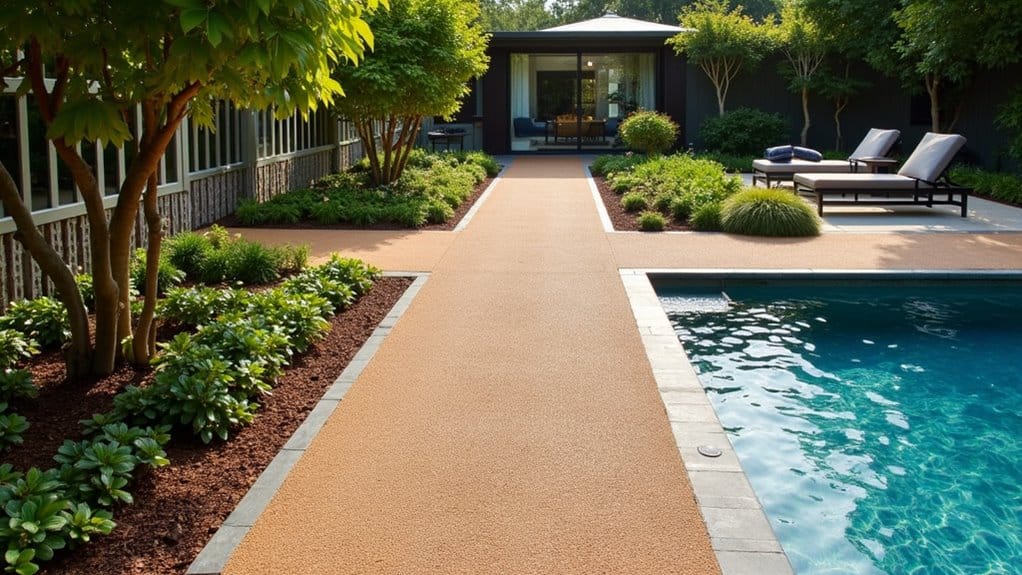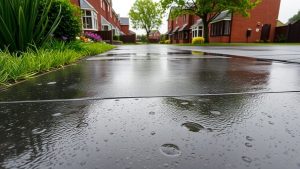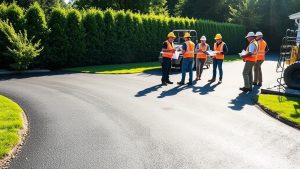The ideal time to install a new driveway is during late spring or summer. These seasons offer perfect temperatures, typically between 20°C and 30°C, which are crucial for the proper curing of asphalt and concrete. This helps prevent issues like cracking or brittleness that can occur in extreme weather. Early autumn can also work, but be cautious of the impending cold. Installing in winter is risky due to freezing temperatures, while excessive heat during high summer can affect the quality of the materials. It’s important to consider your local climate to choose the best timing for your driveway project, ensuring it lasts longer and remains durable.
Table of Contents
ToggleKey Takeaways
The best time to install a new driveway in the UK is during late spring and summer. These months provide the ideal warm temperatures for asphalt installation, ensuring proper curing. Early autumn is also a good option, as the weather remains mild before the colder months set in.
Spring is particularly favourable, with its moderate temperatures and lower humidity helping to prevent surface issues during installation. It’s best to avoid winter and late autumn for driveway work, as freezing temperatures can hinder the process and de-icers may cause damage.
When planning your installation, take local climate patterns into account to ensure the best results and contractor availability.
Temperature Impact on Installation
When installing a new driveway, it’s crucial to consider the impact of temperature on the process. The ideal range for laying asphalt is between 10°C and 32°C. If it gets too hot, the asphalt can cool too quickly, leading to poor compaction and potential cracking, which can reduce the lifespan of your driveway. On the flip side, low temperatures can prevent the asphalt from setting correctly, risking inadequate compaction and structural problems. Conditions below 10°C are particularly concerning, as cold weather can cause surface damage and early deterioration. Therefore, it’s best to avoid asphalt installation during colder months. Rain can also pose challenges; wet conditions can weaken the base layer and affect adhesion. Additionally, adequate drainage is crucial to prevent moisture-related issues during installation. Scheduling your installation during dry periods with suitable temperatures is essential for ensuring a long-lasting driveway. It’s important to remember that the base stability of the surface is also influenced by the weather conditions during installation.
Best Seasons for Asphalt Driveways

Choosing the right season for installing an asphalt driveway can significantly affect its quality and durability. The warmest months are generally the best, as they ensure the asphalt remains pliable and adheres properly, enhancing the overall appearance of your driveway. Late spring and summer provide ideal temperatures, while early autumn is also a suitable option before the colder weather sets in. Optimal conditions are crucial for successful paving, as they promote better adhesion and compaction of the asphalt.
Here’s a straightforward overview of the best seasons for asphalt driveways:
| Season | Pros |
|---|---|
| Spring | Rising temperatures, reduced frost risk |
| Summer | Consistently warm, optimal workability |
| Early Autumn | Mild conditions, suitable for installation |
| Winter | Cold temperatures hinder installation |
| Late Autumn | Often too chilly, risking poor quality |
Planning ahead is crucial, as the paving season comes to an end once the ground freezes. Working in colder conditions can pose challenges that may compromise the integrity of your driveway. By scheduling your project during the warmer months, you ensure a durable and attractive surface that enhances your home’s curb appeal.
Ideal Conditions for Concrete Driveways

Installing a concrete driveway requires careful attention to the right conditions to ensure its durability and strength. For optimal curing, aim for temperatures between 10°C and 21°C. Low to moderate humidity is crucial; too much moisture can prolong curing, while too little may lead to rapid drying and cracks. Always check the weather forecast to avoid rain or snow, as these can dilute your concrete mix and compromise its integrity. A higher concrete PSI is recommended for driveways in regions prone to severe weather conditions, as it enhances durability against environmental stresses.
Calm, dry conditions are ideal for pouring. High winds can cause rapid evaporation, increasing the risk of cracks. If windy weather is unavoidable, consider using windbreaks to protect your work.
Spring and autumn are generally the best seasons for installation, as they offer manageable temperatures and humidity. In contrast, summer heat can lead to surface cracks, while freezing winter temperatures can halt curing altogether.
Proper curing techniques are essential. Keeping the surface moist during the initial curing phase prevents rapid drying.
Additionally, applying a UV-resistant sealer can protect your driveway from heat damage and moisture penetration, ensuring it remains strong and visually appealing for years to come.
Regional Climate Considerations

Regional climate factors are crucial when deciding the best time to install a new driveway, as weather conditions can significantly affect the surface’s longevity and appearance.
In colder climates, freeze-thaw cycles can damage asphalt, leading to cracks and potholes. Consider using concrete instead, as it’s more durable and resistant to cold weather damage, making it a suitable option for regions with long winters and snow. A stable sub-base is also important to prevent further degradation of the driveway in these conditions, especially when using concrete.
In contrast, hot climates may cause asphalt to soften, resulting in depressions. Regular seal coating is essential to protect against UV rays and heat damage.
For areas with heavy rainfall, moisture can weaken the bond between asphalt and its base, creating unsightly potholes. It’s vital to have adequate drainage systems in place, and you may need to carry out regular maintenance to prevent erosion. Using a permeable base will enhance water drainage, ensuring SUDS compliance and reducing damage from moisture.
If you experience variable weather, aim to install your driveway during warmer temperatures—ideally above 10°C—usually from late spring to early autumn.
Consulting with professionals who understand local conditions can help you select the right materials and timing, ensuring your new driveway lasts.
Spring Installation Benefits

Spring is an ideal time to install your new driveway due to the favourable temperatures that aid in proper curing.
With lower humidity levels, the concrete gains strength without the danger of quick setting or cracking. This season simplifies the installation process, resulting in a more durable and reliable final product. Additionally, installing a driveway in spring allows for a long-lasting driveway surface that can endure for decades with minimal maintenance. Proper installation can significantly impact the driveway’s lifespan and durability, ensuring it remains functional and attractive for years to come.
Optimal Temperature Conditions
The best time to install an asphalt driveway is in spring, when temperatures are typically between 20°C and 30°C. These conditions keep the asphalt malleable, allowing for effective compaction and strong joints. This temperature range significantly lowers the risk of defects, which can be a problem in colder months.
In spring, the ground temperature is usually just right, preventing the asphalt from cooling too quickly and ensuring a smoother installation. Warmer weather also reduces the effects of wind and humidity, which can speed up cooling times. Professional contractors can take advantage of these ideal conditions and use techniques that work best in warmer weather.
Additionally, spring tends to have less rainfall than summer, leading to a more reliable installation process. By scheduling your driveway project in spring, you not only benefit from optimal temperatures but also protect your investment, ensuring a durable and attractive addition to your home. Furthermore, maintaining proper compaction during installation is crucial for the longevity of the driveway.
Manageable Humidity Levels
Installing a new driveway in spring ensures manageable humidity levels that improve the concrete curing process. The moderate temperatures during this season create an optimal environment, allowing for even and effective curing. Additionally, the ground thawing during spring enhances the workability of materials, making it easier to achieve a solid foundation.
Here are some key advantages of spring installation:
- Even Curing: Moderate humidity helps maintain consistent moisture levels, which is vital for the first five to seven days after installation.
- Fewer Surface Problems: Balanced humidity reduces the risk of scaling and pitting, which can compromise your driveway’s integrity.
- Slower Evaporation: Controlled humidity prevents rapid evaporation of water, enabling the concrete to achieve its maximum strength.
- Proper Drainage: Implementing effective drainage techniques is crucial to avoid water pooling, which can disrupt the curing process.
To keep humidity levels manageable, use humidity control methods and moisture measurement tools while monitoring the weather.
Schedule your installation during dry spells and prepare the ground to direct water away. Taking advantage of spring’s favourable conditions not only leads to a stronger driveway but also helps you avoid issues related to extreme humidity changes.
Reduced Installation Challenges
Installing a new driveway in spring can significantly simplify the process. The moderate temperatures, usually between 10°C and 30°C, ensure that concrete cures properly, enhancing durability and reducing the chance of cracks.
With the ground thawed, site preparation is easier, allowing for effective grading and leveling, which helps prevent future settlement issues.
Spring weather is generally predictable, which means fewer project delays. This allows for better planning and execution, as improved workability and drainage can be taken advantage of. The lighter vegetation makes it easier to clear away weeds and debris quickly.
Moreover, spring installations typically occur before the peak summer traffic, minimising disruptions to your daily routine. This often results in quicker project completion, so your driveway will be ready for use sooner.
Summer Installation Challenges

While summer might seem like an ideal time to install a new driveway, the season presents several challenges that can affect the quality and lifespan of your concrete. The heat and humidity can speed up the curing process, potentially leading to problems with strength and durability.
Here are four key challenges to consider:
- Temperature Control: The best pouring temperatures are between 10 and 32 degrees Celsius. Going above this range can weaken the concrete.
- Surface Integrity: High temperatures can make the surface brittle, increasing the likelihood of spalling and cracking.
- Moisture Maintenance: It’s crucial to keep the concrete moist during the curing phase. Rapid drying can create weak spots.
- Soil Conditions: Dry soil can shrink, worsening cracking and compromising the driveway over time.
Being aware of these challenges can help ensure a successful installation.
Fall Installation Advantages

Choosing to install your driveway in autumn presents several significant advantages that can improve both the quality of the work and the lifespan of the surface. The cooler temperatures are ideal for the curing of concrete, enhancing the appearance of your driveway and reducing the likelihood of surface cracking. Additionally, with lower humidity and less rain, you can anticipate fewer delays in the installation process.
Here’s a quick overview of the benefits of autumn installation:
| Advantage | Details |
|---|---|
| Ideal Weather Conditions | Cooler temperatures and low humidity promote better curing. |
| Improved Working Environment | Comfortable conditions increase labour efficiency. |
| Preparation for Winter | Ensures proper sealing before freezing temperatures. |
| Easier Scheduling | A quieter season allows for more flexible booking dates. |
| Simplified Material Handling | Easier access helps to minimise the risk of damage. |
Winter Installation Risks

As autumn’s mild conditions give way to winter’s chill, installing a new driveway becomes more challenging.
Winter installations carry significant risks that can affect the durability and performance of your driveway. Here are some key considerations:
- Temperature Concerns: Freezing temperatures can cause concrete to crack and asphalt to compact improperly. The ideal temperature range for laying asphalt and concrete is between 10°C and 32°C, making winter far from ideal.
- Damage from De-icers and Equipment: De-icing chemicals can seep into concrete, resulting in scaling and cracking. Additionally, heavy snow removal machinery can chip away at your new surface, leading to premature damage.
- Weather-Related Problems: Rain and flooding can compromise your driveway’s structure. Water can infiltrate during thaw cycles, causing further damage when the ground freezes and thaws again.
- Preventive Steps: If you decide to go ahead with installation, ensure proper winter preparation by sealing your driveway and using environmentally friendly de-icers. Regular maintenance can help mitigate winter wear.
Given these risks, it may be wise to consider installation during the warmer months for the best results.
Humidity and Curing Process

Humidity is crucial in the curing process of concrete, affecting its strength and longevity. When installing a new driveway, it’s essential to understand how humidity impacts curing.
Moderate humidity levels support proper curing by helping the concrete retain moisture. However, low humidity can lead to rapid moisture loss, resulting in cracks and structural weaknesses. On the other hand, high humidity can hinder moisture evaporation, complicating the curing process and preventing the concrete from setting correctly.
To ensure optimal curing, stable weather conditions are important. Consistent moisture during the initial curing phase is ideal, so consider methods like water curing or using wet coverings to minimise moisture loss.
Applying a curing compound can also be beneficial in preventing moisture evaporation.
Temperature also plays a role, interacting with humidity levels. It’s best to pour and cure concrete when temperatures range between 10°C and 27°C (50°F to 80°F).
Professional Contractor Insights

When it comes to driveway installation, selecting the right contractor is crucial for ensuring a long-lasting finish.
Seasonal installation techniques are important; experienced professionals can adapt their methods to local weather conditions, which helps with proper curing and durability.
Choosing the Right Contractor
Choosing the right contractor for your new driveway can be daunting, but knowing what to look for can make the process smoother. Here are key qualifications to consider:
- License Verification: Always check a contractor’s licence with your local authority to ensure they’re properly registered.
- Experience: Aim for a contractor with at least five years of experience, as this often correlates with quality workmanship.
- Professional Certifications: Ensure that the contractor has the necessary qualifications and adheres to local building regulations.
- Customer Reviews: Look at their reviews on platforms like Trustpilot or Checkatrade to gauge customer satisfaction and reliability.
Communication is also crucial. Keep discussions about project timelines and material choices clear and open. This not only builds trust but also helps set mutual expectations.
You want a contractor who listens and responds thoughtfully. By focusing on these aspects, you can make an informed choice and pave the way for a successful driveway installation.
Seasonal Installation Strategies
Choosing the right contractor is crucial for a successful driveway installation, but the timing of the project is equally important. The best time for installation depends on the season and the materials used.
For asphalt driveways, late spring to early summer is ideal, with temperatures around 21 degrees Celsius ensuring quality results. If you live in a warmer area, you may have a longer window for installation.
Concrete, however, requires moderate temperatures and low humidity for proper curing, making spring and autumn the best times. Extreme weather, such as high heat or rain, can lead to cracks or inadequate curing. While your contractor can handle some weather-related issues, starting your project in favourable conditions will yield better outcomes.
Planning ahead is beneficial too. By scheduling your installation early in the season, you’re more likely to receive competitive quotes and avoid delays.
Adaptation to Local Conditions
Adapting to local conditions is crucial for a successful driveway installation, and professional contractors are well-equipped to handle these challenges. They understand how environmental factors can impact the project.
Here are some key considerations they take into account:
- Ideal Temperatures: For the best results, concrete should be poured when temperatures are between 10°C and 32°C.
- Moisture Control: It’s important to keep the surface damp during curing, but it shouldn’t be soaked.
- Local Climate: Contractors evaluate your area’s climate, as warmer regions can have longer installation periods than cooler ones.
- Specialised Equipment: Professional tools enhance installation methods, ensuring proper compaction and efficiency, even in difficult weather conditions.
Maintenance Requirements for Driveways

To keep your driveway in good condition, regular maintenance is essential to avoid expensive repairs later on.
Begin with monthly checks to identify potential issues early, such as cracks or signs of pooling water. Ensure your irrigation systems aren’t watering the driveway, as this can lead to premature wear.
Seasonal maintenance includes clearing away debris like leaves and dirt using a broom or hose. For stubborn grime, pressure wash every two weeks.
Protect the edges by avoiding driving on them and reinforcing with topsoil and grass. If there are any oil or petrol spills, clean them up straight away to prevent the asphalt from softening.
Sealing cracks is crucial; address them promptly to prevent water damage and freeze-thaw issues.
Reseal your driveway every two to three years, ideally in the summer for the best results.
Scheduling and Permitting Factors

When planning your new driveway installation, it’s important to understand local permit requirements to avoid any delays.
Seasonal variations in workload can impact contractor availability, so having some flexibility in your schedule can be beneficial.
For example, if you can consider off-peak times for installation, like early spring or late autumn, you may find it easier to secure a contractor.
Local Permit Requirements
Securing the necessary permits is crucial for a successful driveway installation, and understanding local requirements can save you time and hassle.
Here’s a straightforward guide to the permit application process:
- Submit Your Application: Before starting, ensure you submit a driveway permit application with a detailed plan of the proposed driveway.
- Check Zoning Compliance: Confirm that your project complies with local zoning laws, including any necessary zoning permits and setback requirements.
- Prepare Essential Documents: Collect all required documents, such as a property owner affidavit (if applicable), proof of insurance, and your contractor’s licence.
- Follow Local Regulations: Be aware of design standards, environmental considerations, and any required modifications for public infrastructure.
While navigating these requirements can seem complex, they’re essential to avoid delays.
Local regulations often specify what’s needed, so consulting your council’s guidelines can provide valuable insight.
Seasonal Workload Variations
Navigating seasonal workload variations in driveway installation can significantly influence your project’s timeline and budget. It’s crucial to grasp the installation trends and scheduling strategies that differ by season. During peak seasons, such as spring and summer, demand for contractors surges, resulting in longer wait times and potentially higher costs. In contrast, off-peak seasons allow for lower labour costs and greater flexibility in scheduling.
Here’s a quick summary of how seasonal variations can affect your project:
| Season | Demand Level | Cost Implications |
|---|---|---|
| Spring/Summer | High | Increased labour/material costs |
| Autumn/Winter | Low | Discounts and reduced costs |
| Year-Round | Varies | Regional climate effects |
Opting for driveway installation during off-peak periods not only helps you avoid scheduling conflicts but also reduces the likelihood of weather-related delays. By recognising these seasonal variations and adapting your strategy accordingly, you can streamline your project and ensure a successful installation that stays within budget. Remember, timing is essential; it can make a significant difference to your driveway project.
Scheduling Flexibility Benefits
Planning your driveway installation early can offer valuable scheduling flexibility, especially when dealing with permits and contractor availability. By starting the process in January, you can avoid the busy spring and summer periods.
Here are the main benefits of early planning:
- Greater Scheduling Flexibility: You’ll have more options for completion dates, steering clear of peak times.
- Improved Contractor Availability: Contractors tend to have more free time in off-peak seasons, making it easier to secure your preferred tradesperson.
- Smoother Permitting Process: Early planning helps you anticipate and manage the varying processing times for permits from local authorities, reducing potential delays.
- Favourable Weather Conditions: Installing during dry, warm spells ensures optimal conditions for asphalt work, minimising the risk of weather-related interruptions.
By planning ahead, you gain the flexibility needed to manage timelines effectively, ensuring your driveway installation proceeds seamlessly.
This proactive approach not only saves you time but can also lead to cost savings, making it a wise choice for homeowners looking to enhance their driveways.
Cost Considerations by Season

When planning to install a new driveway, the season you choose can significantly affect your costs.
In spring, you’re likely to find lower material prices and better availability of labour, as contractors are eager to fill their schedules before the summer rush. The milder weather also means fewer delays and optimal conditions for concrete curing, making it a sensible choice for budget-conscious homeowners.
Summer tends to be pricier, with increased demand driving up labour costs and material prices. Scheduling can be challenging as contractors are often fully booked, and extreme heat may compromise the quality of the concrete.
Autumn offers a good balance, with moderate material costs and generally favourable weather for installation. You may find availability improves as contractors look to fill their schedules before winter, and some might offer discounts.
Winter usually incurs the highest costs due to harsh weather, which requires specialised equipment and additional protective measures. Labour availability can be limited, leading to possible delays in your project.
Environmental Factors Influencing Installation

Environmental factors are crucial for the success and longevity of your driveway installation.
Being aware of these elements can guide you in selecting installation methods that reduce environmental impact. Here are four important considerations:
1. Temperature: High temperatures can cause asphalt to cool too quickly, resulting in a rough finish.
For concrete, extreme heat can impede proper curing.
2. Humidity: Elevated Humidity can slow concrete curing, leading to potential surface defects.
On the other hand, low humidity can cause rapid evaporation, increasing the risk of cracks.
3. Seasonality: Spring and autumn are the best times for installations, as they typically offer moderate temperatures and lower humidity.
It’s wise to avoid the heat of summer and the freezing conditions of winter.
4. Material Choices: Opt for warm-mix asphalt, which lowers energy use and emissions during installation, promoting better environmental sustainability.
Long-Term Durability Factors

Installing a driveway involves more than just selecting the right time and materials; its long-term durability depends on several key factors during and after the installation.
First, consider material compatibility. Choosing materials that suit your local climate and the expected traffic is crucial for ensuring longevity. High-quality materials, when reinforced properly, can better withstand environmental challenges than inferior options.
Next, installation quality is vital. A skilled contractor will ensure proper base preparation, including effective drainage and compaction, which are essential for durability. Additionally, a thorough curing process for concrete is necessary to achieve maximum strength.
After installation, maintenance becomes imperative. Regular cleaning and sealing protect against weathering and stains, while promptly repairing any cracks can prevent further damage. Seasonal precautions, such as using salt in winter and sealing in summer, also help to extend your driveway’s lifespan.
Lastly, understanding your driveway’s design and load capacity affects its resilience. Incorporating proper drainage can prevent water build-up, which is crucial for maintaining structural integrity.
Frequently Asked Questions
How Do I Prepare My Yard Before Driveway Installation?
Before installing your driveway, start with soil testing to ensure it has the right stability. Next, grade the yard to promote proper drainage and prevent water pooling. Clear away any debris and old materials to provide a clean site, which is essential for a strong foundation and successful installation.
What Materials Are Best for Driveway Surfaces?
When choosing a driveway surface, consider the benefits of concrete, such as its smooth finish and versatility. On the other hand, asphalt is known for its durability, particularly against adverse weather conditions. Think about your local climate and your personal preferences to determine the best option for you. For instance, if you live in an area with extreme temperatures, asphalt might be the better choice due to its resilience.
Can I Install a Driveway Myself?
Installing a driveway yourself can be a rewarding project if approached correctly. With the right DIY tips, you can tackle challenges confidently. However, assess your skills and the complexity of the materials before starting the installation. For example, laying block paving might require more expertise than a gravel driveway. Always ensure you’re prepared and informed before taking on the task.
How Long Will the Installation Process Take?
The installation timeline can vary depending on the type and complexity of your driveway. Factors such as weather, including temperature and rain, can significantly impact progress. It’s essential to plan for adequate preparation and good weather to ensure a smooth installation process. For example, laying a tarmac driveway in wet conditions may lead to delays.
What Should I Do Immediately After Installation?
After installation, seal your driveway within 6-12 months. Avoid heavy traffic, and ensure you clean it regularly. Pay attention to the weather for maintenance advice, and keep an eye on drainage to prevent damage from standing water or extreme temperatures.
Conclusion
Timing your driveway installation is crucial. Just as flowers bloom in spring, a new driveway can significantly enhance your home’s appearance. Consider factors like temperature, local climate, and seasonal pricing. You’re not just laying a surface; you’re investing in durability and aesthetics. Remember, choosing the right season can ensure a smooth finish that lasts, much like your fondest memories.
Prepare the perfect base for your resin bound stone installation and discover the crucial factors that ensure lasting durability.
Know where resin bound surfacing can transform spaces for both residential and commercial use, and discover the countless benefits that Read more
A stone carpet combines beauty and resilience in flooring, but what makes quartz floors uniquely beneficial? Discover the secrets behind Read more










